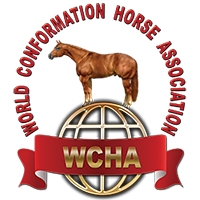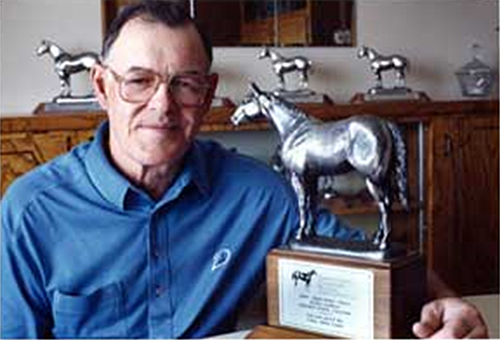
In Memory Of Calvyn Maxwell Loree
August 16, 1930 (Roland, MB) ~ May 9, 2013 (Calgary, AB)
WCHA Founding Member
(Left) Calvyn Loree has won many awards for his horses he has owned, including this trophy for the 1987 AQHA High Point Halter Horse for Sheiks Whim.
On the Quarter Horse Trail
Cal and Rosemarie Loree find horses everywhere they go.
By Honi Roberts
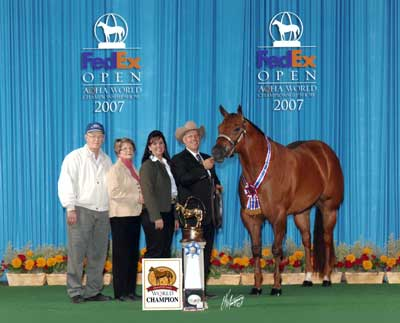
CRL Shesa Cool Coosa represents the culmination of the Loree breeding program, blending the bloodlines of Coosa, Perpetualism and Ima Cool Skip. From left, Cal and Rosemarie Loree celebrated with Rebecca and Wayne Halvorson when the mare was the top 3-year-old mare at the 2007 AQHA World Championship Show. “J-Lo” now belongs to the Halvorsons.
“It meant a lot to me,” said Cal Loree, 78, with characteristic understatement. ‘It’ was watching as CRL Shesa Cool Coosa, a charismatic sorrel that epitomizes his nearly 30-year-old breeding program, was named the 2007 world champion 3-year-old mare.
“Before the class started, I overheard a couple of men seated nearby; one asked who would win the class,” Cal recalled. “His friend answered, ‘There’s only one that should’ and named our mare. I had to chuckle.”
Today, the celebrity mare nicknamed “J-Lo” is one of the most highly decorated AQHA champions of our day, with four world and two youth world titles as we go to press before the 2008 World Show.
“I never much cared about owning a world champion, but I wanted desperately to breed one – and that took almost 20 years! My wife, Rosemarie, and I loved her at first sight,” Cal added, as if sharing a wonderful secret. “You know, I’ve had horse people tell me that she’s almost perfect.”
Cal and Rosemarie’s love affair with horses began long ago; north of the border and a world away from any show arena.
Life in the Prairie Provinces
Cal was born on a grain farm in southern Manitoba, Canada, when farming relied on the stout shoulders of heavy work horses. Young Cal occasionally caught a ride on their broad backs, and an appreciation for horseflesh that has lasted a lifetime was born.
Rosemarie grew up a few hundred miles to the west on an Alberta farm.
“My three sisters and I drove a horse and buggy to our country school,” she reminisced. “Our horse was big and old, and built like a moose, but we loved him. When we got to school, we’d unhook him and put him in the barn with a bundle of feed. All the children arrived the same way, and there were runaways daily. Today, our grandkids hardly believe me.”
When he was 22, Cal moved to Alberta to begin his career in Canada’s oil industry.
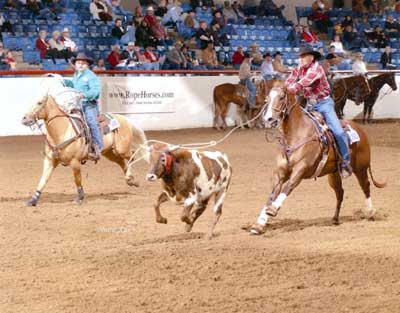
The Favourite Son
No doubt about it: Of all the stallions they’ve owned, there is a special spot reserved in Cal and Rosemarie Loree’s hearts for two-time world reserve champion stallion Coosa.
“He was easy to love,” Rosemarie said, “with his big eyes and pretty face.”
They recount the story of a couple who brought their champion mare to Loree Quarter Horses to breed to Coosa’s stablemate, Ima Cool Skip.
“After meeting Coosa,” Cal said, “they had to send another mare to us for him. Coosa had that effect on you.”
Today, the 1982 stallion is an AQHA top-12 all-time leading sire of halter ROMs, including three-time world champion Coosa Classic. While noted for halter offspring, Coosa was not limited just to conformation horses. He also sired Coosas Jet, who earned a Superior in amateur western pleasure.
AQHA Director Rodger Coday owns Coosa Jule, a Coosa gelding, he said, “with his daddy’s beautiful head and expressive eyes.”
Coosa Jule, originally purchased as a trail horse for Rodger’s partner, Joyce Pendergrass, has become one of his favorite roping horses.
Coosa Jule, above, is part of the family for Rodger Coday and Joyce Pendergrass. “He’s so smooth, he just floats out of the box,” Rodger said. “A couple years ago, we led (for a while) in breakaway roping, and one year, we were top 10 in heading. There are always a half-dozen people who want to buy him, but he’s not going anywhere. If you’re lucky, in a lifetime, you might bond with one or two horses, and he and Joyce have that special bond.”
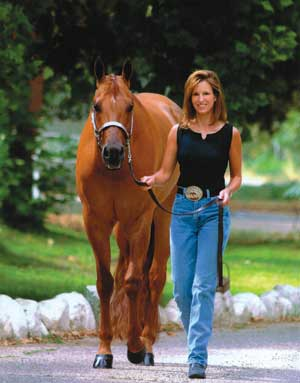
“I think Acoosamatic has his grandfather’s pretty, intelligent eyes and regal temperament. He never has a bad day. I’ve had so much fun with him – he’s a dream come true.”
Photo at right: Renee Howes shows Acoosamatic in hunter under saddle and halter. He was the 2007 AQHA Bayer Select world champion in performance halter geldings.
As much as the Lorees loved Coosa, six years ago they sold him to Eric and Tammy Hammond of Rosewood Horse Ranch in Kansas.
“Coosa is a unique and very special individual,” Eric said. “He’s a gentle giant, and in very good shape for his age.”
For a few years following their purchase, Coosa stood at Halvorsons’. Then the Hammonds decided to bring the legendary stallion home, so they could appreciate him on a daily basis.
“We took breeding classes, and when we needed to refine steps, Coosa helped us figure it out,” Eric said with a slow smile. “We bought him on Tammy’s birthday, and he’s been an awesome present for both of us. He’s a good ol’ boy, with a quiet wisdom about him. He makes people want to reach out and touch him, and I believe he likes it. Coosa is not one to turn his back on you.
“He’s our favorite, too.”
“During those early years, I had little to do with horses,” Cal said, “unless I got a chance to watch heavy-horse hitches at a local event.”
Almost two decades had transpired when Cal walked into the office of Eskimo, an oil well service company, and met Rosemarie, an office manager and bookkeeper.<.br>
“I cannot explain it,” she mused, “except to say that I was immediately drawn to him. I just knew he was for me.”
Time passed, and the couple married December 17, 1971. It was the second marriage for both, and they had four daughters to raise.
Cal’s brother owned a farm near Calgary, Alberta, and it wasn’t long before the couple decided to purchase some riding horses: American Quarter Horses. Years went by. As their daughters, young women now, pursued other interests, the couple, like many empty nesters, devoted increasing amounts of time to their horses. In 1981, they entered their first horse show, and in 1982, the first foal bred by Loree Quarter Horses arrived.
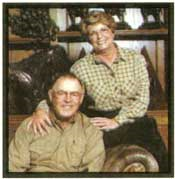
“Cal and I followed our dream,” Rosemarie said. “In the beginning, we both worked full time at demanding jobs and made the time for our horses. It started innocently enough. We had 20 acres and a 12-stall barn, and we did all the chores. Cal gave the shots, and I doctored any cuts and scrapes. In the spring, I foaled out mares, then imprinted and halter broke the babies.”
“During our Canadian winters, it frequently registered 40-below during 5 a.m. chores, and I’d ask myself, ‘Where’s the fun in all this?’ But in truth, we loved the horses like our kids, and if it meant going out in the middle of the night to give them some extra feed on really cold nights, that’s what we did.”
The halter arena beckoned.
“I’d always liked conformation shows, so halter classes had an attraction for me,” Cal said. “I suppose if I’d been more of a rider, I would’ve been more interested in performance, but I prefer breeding and raising horses, and watching a show as opposed to being a showman myself.”
“I’ve never even owned a hat,” Rosemarie added with a smile. Initially, she was less than enthusiastic about showing. “My position was, ‘If he thinks I’m going down the road chasing after horses to a show, he has another think coming.’”
She didn’t know then, but she was the one with a surprise in store.
In 1981, the Lorees had a local trainer take four of their horses to the spring show in Edmonton, Alberta. Their pleasure mare, Lee Mac Dolly Too, won easily, as did Tiny River, their 2-year- old filly.
“One show and I was hooked,” Rosemarie said. “Then, ‘Dolly’ won six or eight classes in a row. We became so accustomed to winning that when she didn’t, we looked at each other with our mouths open in shock.”
They took the two mares to the AQHA World Championship Show that year, and were shocked again.
“We just were not competitive south of the border,” Cal said. The winners were much more big-bodied and muscled than the Lorees’ horses. “We weren’t used to being overlooked. It was an eye-opener.” The couple returned home more determined than ever to breed horses competitive at the highest level. They’d soon meet a young man who would help them reach that goal and who would become a partner and lifelong friend.
You Gotta Have Friends
Wayne Halvorson grew up on a cattle ranch in North Dakota, and trained his first horses for clients at the tender age of 10, while he still showed in 4-H and FFA. He earned a degree with honors at the University of North Dakota, and spent part of the summer show season in Alberta, where he met Cal at a horse sale. In short order, the Lorees sent a young stallion home with Wayne.
“Wayne was an honorable young man then, and he still is today,” Cal said. “I told him that I knew when I got into this, I wasn’t going to make any money, but that we were going to be honorable in all of our dealings.”
Wayne frequently showed the Loree horses in Canada.
In late 1984, the Lorees purchased a long weanling stallion, Sheiks Whim, (Impressive Sheik x Miss Badger Gal). The next year, they sold half interest in the colt to Pete Rice and eventually stood him at the Rice ranch. In 1987, Sheiks Whim was the AQHA high-point halter horse. “He was fine-minded and kind,” Cal said. “And his offspring were, too.”
Indeed, they include World Show competitors, AQHA Champions and individuals with halter and performance Superiors and Registers of Merit. It was also a Sheiks Whim offspring who would be the focus of Rosemarie’s brief but shining show career.
“I decided to fit one of his beautiful bay daughters for show,” she recalled. “I longed and groomed her, monitored everything she ate, then had Corky Warren, who campaigned Sheiks Whim for us, show her at the Edmonton Spring Show. She went grand champion mare. That was it for my show career – I quit on top.”
Meanwhile, Cal spent his last 15 years in the oil business as an owner and manager of Canadian Fracmaster, LTD. When he divested his interest and retired in 1993, the couple contemplated their options – and they all included Quarter Horses.
“The Lorees wanted a trainer, and considered building a facility in Canada or Texas,” Wayne recalled. “I’d trained and shown their horses for years, and had a couple with me when the ranch I worked at in Oklahoma went on the market. So we considered the possibility of a partnership.”
The Lorees had become close to the entire Halvorson family.
The deal was sealed; the ranch in Guthrie, Oklahoma, became the new location of Loree Quarter Horses. The partnership between the the Lorees and the Halvorsons was official.
Indomitable Spirit
When the Lorees purchased the Oklahoma ranch, they moved on site and lent their considerable energies to building a home for themselves, as well as updating and constructing fencing, a mare motel, covered arena and a world-class breeding barn. Cal had been a heart patient since 1972 and endured heart bypass surgery in 1976 without slowing down. But a heart-stopping moment (literally) in an Oklahoma show pen gave everyone pause.
Helping qualify some of the Loree Quarter Horses for the 1994 World Show was a welcome respite from the strenuous work at the ranch for Cal. Then one day Rosemarie and the Halvorsons watched thunderstruck as Cal suffered cardiac arrest in the middle of a show ring in Tulsa, Oklahoma. The indomitable retiree survived, both that and another bypass operation, but he made a promise to Rosemarie to slow down – at least just a little.
“It speaks volumes that it didn’t dampen his enthusiasm one bit,” Wayne said, “and it demonstrates the passion Cal has for his horses and the Quarter Horse industry.”
The partners set about breeding halter horses that had huge hips and carried a lot of muscle, yet had eye-catching, refined heads and graceful, well-set necks. Three memorable stallions would help them achieve that goal.
Star Power
In 1993, an 11-year-old, two-time Reserve World Champion stallion became available, and Cal gave Wayne the green light. Coosa (Pretty Impressive x I’m A Rosita) came home to Loree Quarter Horses. A short time later, three-time world champion stallion, Ima Cool Skip (Skipa Star x Susie Impressive) joined him in the breeding barn. “If you want to sell your horses, you need an attraction to bring the public to your ranch,” Cal said. “People came from all over North America to see those two stallions, Ima Cool Skip in particular. He was much loved by the public, and for good reason: He had it all and was a strong breeding horse.
“But Coosa was our all-time favorite stallion,” Cal revealed. “He was very special.”
“Coosa was easy to love, with his great, big eyes – they could melt you – and refined head and neck,” Rosemarie said. “He was a wonderful personality to be around.”
Rosemarie tells the story of Coosa’s personal preferences in the breeding barn.
“The stallions were bred on alternate days, and Coosa could be very picky about his mares,” she said. “Those were the days before shipped semen, and if he didn’t like a mare, he just wouldn’t tease up to her at all. We soon learned that he had a weakness for the windblown look with a tangled mane. The more unkempt a mare looked, the more Coosa loved her!”
It was an exciting time at Loree Quarter Horses and in the Quarter Horse world. The popular stallions bred more than 350 mares each season, keeping staff busy around the clock.
In time, three-time world champion Perpetualism (Kid Clu x Miss Superiority) was purchased from their great friend the late Jerry Wells. The statuesque sorrel stallion added more stellar breeding power to the barn, and proved an excellent cross on their Coosa and Ima Cool Skip mares. It was, as Wayne noted, “a premier time in the halter industry.” And Loree Quarter Horses was right in the middle of it.
CAL LOREE’S BREEDING COMMANDMENTS
• Be patient: Breeding good horses is something you can’t rush.
• Find knowledgeable mentors: If you’re green – like we were – you’ll need them.
• Select bloodlines carefully: They’re vitally important.
• Expect to work your way up the ladder slowly: Competition is tough.
• Always have fun!
Up Close and Personal
Today, Wayne Halvorson is at the top of his game, having trained and shown multiple world champions in halter, western pleasure and hunt seat equitation. Nearly 25 years ago, he met Cal and Rosemarie Loree, who became important mentors, partners and friends. Asked to describe Cal in three words, Wayne complied: honest, competitive and compassionate.
“From Day 1, there was something about his character and his honesty that made me want to conduct my business like he did his – straightforward and fair,” he added. “And Rosemarie is a strong influence and loves the horses just as much as Cal.”
Jim Fleming raises working ranch Quarter Horses in Calgary, Alberta, and has been an AQHA-Candian Quarter Horse Association director since 1986, and served with Cal on the stud book and registration committee.
“Cal is thoughtful and measured in his response to every issue,” he said. “He’s a thinker. His business and managerial experience is evident. Rosemarie is outgoing and open, and a super grandmum.”
John and Gail Muirhead, who raise Quarter Horses and hay on their Camrose, Alberta, ranch, first met the Lorees nearly 30 years ago.
“They’re dedicated to the Quarter Horse, and just about the warmest friends you can imagine,” Gail said. “Cal puts his knowledge and connections to good use at our Alberta Quarter Horse club.”
This year, the Muirheads’ yearling filly won at Canadian Nationals and was headed for the AQHA World Championship Show. The Loree connection? She’s the granddaughter of a beloved mare purchased many years ago from Loree Quarter Horses.
Rodger Coday, horseman and AQHA director from Oklahoma, added, “Each year, we sit near the Lorees at the World Show, and they are as genuine as you can find; cordial and smart. And he sure can pick a winner!”
And finally, AQHA Executive Vice President Bill Brewer described the Lorees this way: “They have been a tremendous asset to AQHA and the American Quarter Horse industry. I wish we had more like them.”
Giving Back
The Loress became heavily involved in the Canadian Quarter Horse Association and its Alberta affiliate, as well as AQHA. Cal serves both as a director. In the 16 years Cal has been an AQHA director, he has served 12 years on the stud book and registration committee, four years on the youth committee and one three-year term on the hall of fame committee.
“When I started,” Cal said, “I thought the stud book committee was dominated by a bunch of really old guys, all suffering from tunnel vision. Now, I’m one of those old guys – although hopefully, without the tunnel vision.”
“That’s what you think,” Rosemarie commented, laughing. In recent years, the committee has visited important, complex issues that have long-lasting impact on the Quarter Horse world.
“Decisions on DNA testing, HYPP and the ‘white rule’ took a lot of careful consideration,” Cal said. “And today there are important issues before us, the registration of cloned horses probably foremost among them. Right now, I can see both good and bad implications from it; you might say I’m kind of sitting on the fence. We tabled the issue last year, but there’s no doubt we’ll have to address it in the near future.”
As a Founding Member of the World Conformation Horse Association, Cal strongly believed the goals and directions of in the newly formed Association.
Looking Forward
The past year has been both challenging and ultimately rewarding for Cal and Rosemarie. Problems with his defibrillator had him in and out of the hospital and “cost him his summer,” he said. But a successful operation in early October has him on the mend.
“I’m coming back real strong,” he said. “We’ve already made reservations for the World Show – you know, we’ve only missed one World Show since 1981.”
There, Cal and Rosemarie will have the opportunity to watch from the stands as CRL Shesa Cool Coosa, now owned by Halvorson Ranch, competes for her seventh world title.
“She blends the bloodlines of Perpetualism, Coosa and Ima Cool Skip in a way that we’d dreamed of,” Cal said. “It’s thrilling to think that we have her full siblings at the ranch.”
The Lorees remain devoted to the entire Halvorson family, including Wayne’s wife, Rebecca, a horsewoman, judge and educator, whom Rosemarie describes as, “Wayne’s wonderful partner and a joy to us – a breath of spring.”
The Halvorson children, Lauren, Austin and Calvyn (Cal’s namesake), are a source of pride for the Lorees, too.
“We love them all dearly,” Rosemarie added.
About a dozen years ago, the Lorees sold their interest in the Oklahoma ranch to Wayne, however, they keep seven or eight broodmares there and continue to breed every year. “Our goal is to become 30-year Quarter Horse breeders, and we have just four years to go,” Cal said. “We always look for- ward to our stays at the ranch: seeing each year’s new babies and welcoming all the people who stop by to say hello.”
“I once said to Cal,” added Rosemarie, her eyes smiling, “that wherever we go, at the end of the trail, there are always Quarter Horses.”
Sadly, Cal Loree passed on May 9, 2013.
